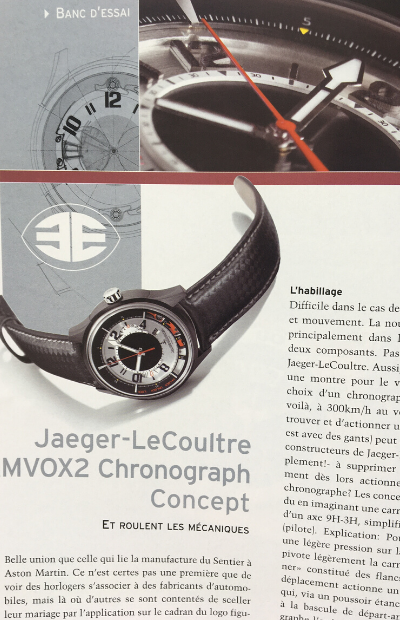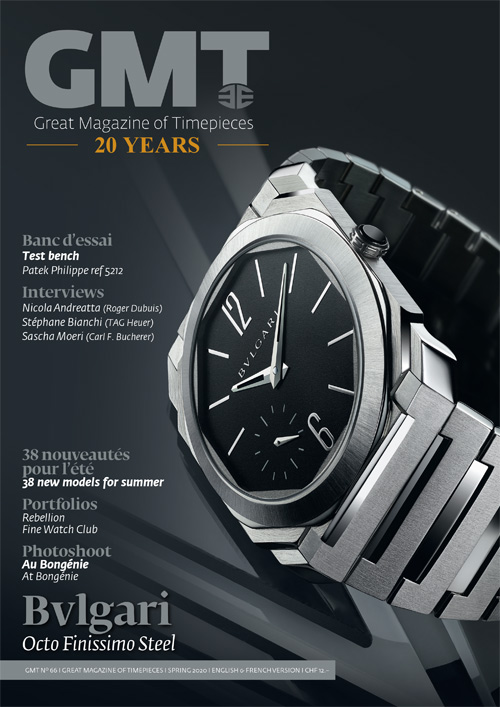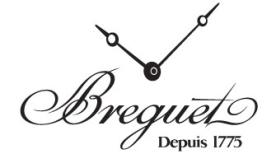In 2006, GMT Magazine continued expanding internationally with the launch of GMT XXL Russia & Ukraine as well as zeroing in on its demographic with the new women’s special edition XXS, produced in collaboration with the women’s magazine Profil. The phenomenon of mono-brand boutiques intensified, as did the desire for second hand Rolexes. Antiquorum auctioned off the largest collection of Rolex watches ever to appear in public sale: 300 Rolex models belonging to publisher Guido Mondani, amassed over 20 years of travel. Brands continued to streamline their production, from major brands to small independent watchmakers, with Bovet taking up residence and opening its museum in the Château de Môtiers in Fleurier, which the descendants of the founding family had bequeathed to the canton of Neuchâtel.
Many tried to ride the wave of a booming watchmaking industry, reflected in advertisements for brands that have since sunk: Bertolucci, DYD, Enigma, Instruments & Mesures du Temps, Robergé, Trebor, U-Boat and Yeslam. Quite the opposite of Montblanc, which celebrated its 100th anniversary and 300th boutique, headed by Jean-Marc Pontroué, for whom “Montblanc has been a creator of soul for 100 years”. Symbolising both a turning point for the brand and a strong trend in luxury watchmaking at that time, Montblanc unveiled its first major complication, the Star Chrono GMT Perpetual Calendar.
Innovation in all directions
Independently of volume, a certain contrast emerged in luxury watchmaking with, on the one hand, independent craftsmen and designers not shying away from innovation, and on the other hand, traditional manufacturers weighing the pros and cons of this quest for spectacular performance. A champion for ostentatious luxury but now enriched with a strong technical know-how, Jacob & Co. presented its enormous Quenttin with axial time display (on rollers, without hands), using 7 barrels providing 31 days of power reserve, at the heart of a steel, gold and carbon case, radically interwoven with the movement. Equally impressive in terms of design and mechanical audacity, Vianney Halter and DMC have created the extra-terrestrial-shaped Capestan, which is set using a winding stem that pops out of the case. The transversal construction of the mechanism with fusée and tourbillon is as innovative as its time indication on engraved rotating cylinders.
More inside the box, comparatively, was the Monopoussoir Chronograph with 5 coaxial hands and isochronic balance-spring designed by De Bethune, featuring 3 patents and “only” 172 hours of power reserve. As for François-Paul Journe, he showcased his expertise with a Grande Sonnerie Souveraine in steel with 120 hours of power reserve, protected by 10 patents. In particular, he had developed systems that both facilitated the use of the Grande Sonnerie and made it more secure. The winding stem, for example, locks when an alarm is active. The striking mechanism locked after 48 hours of operation to protect the power reserve.

All the more impressive was Patek Philippe, who unveiled its own balance-spring, the Spiromax, in monocrystalline silicon, already used in the escapement wheel designed the year before by its R&D department. At the same time, Patek Philippe presented its first in-house chronograph caliber, to equip the Platinum Annual Calendar Automatic Chronograph with flyback and power reserve display.

This complication also inspired another great secular Manufacture, Jaeger-LeCoultre, whose AMVOX2 Chronograph Concept has the chronograph started by pressing on the upper part of the sapphire crystal. On a more significant watchmaking register, its Triptyque Reverso stands out as the first wristwatch equipped with a détente escapement, known to have obtained the best results in terms of mechanical adjustment, particularly on marine chronometers, and integrated here with a tourbillon.

A whirlwind in all its forms
Watches equipped with tourbillons explode on the scene in all forms. At Roger Dubuis, 16 of the 160 novelties of the SIHH that year have a tourbillon integrated, including one with constant force for ladies, and another with a square shape, the GoldenSquare Tourbillon in titanium. Audemars Piguet chose the oval for its Millenary MC12 Tourbillon Chronograph in platinum, named after its partner’s, Maserati, 700-horsepower racing car. It is obviously the tonneau that is the order of the day at Richard Mille with the RM 008 Tourbillon Chronograph in pink gold, water-resistant to 100m.
On a more alien plane was the HM1 from MB&F, designed by Laurent Besse and Peter Speak-Marine, which housed two dials linked by an elevated central tourbillon in the centre, four mainspring barrels and a “battle-axe” shaped automatic winding rotor. The large case size is also reflected in the DNA of the Sea Hawk II Tourbillon in titanium and pink gold, water-resistant to 1000m by Girard-Perregaux, or in Franck Muller’s tourbillon Aeternitas with equation of time, split-seconds chronograph and triple time zone, whose perpetual calendar is programmed for 1000 years. Less extreme was Peter Speake-Marin’s Tourbillon Piccadily Répétition Minute in platinum with perpetual calendar and moon phases, which showed collectors what they could expect from him. Among independents, DeWitt continued its demonstration with a new world first, the Constant Force Tourbillon, whose patented constant force device absorbed the force coming from the barrel every second and redistributed it to the tourbillon every 10 seconds.

2006 was also distinguished by watches with a tourbillon moving around the dial. On the front page of the GMT was Piaget’s Tourbillon Relatif Polo, which achieved the feat of hooking its cage to the minute hand and thus rotating around the dial. The principle is similar with the Tourbillon Orbital by Jean Dunand equipped with a Christophe Claret calibre. Even stronger at Breguet, whose Grande Complication featured a double independent tourbillon on a single axis that completed its rotation of the dial in 12 hours.

David & Gloliath: the take from CEOs
Big bosses and small entrepreneurs give voice through various media to claim their territory or legitimacy in the territory of exclusivity and haute horlogerie. As the new CEO of Vacheron Constantin, Carlos Torres made a lucid analysis: “Vacheron Constantin has been around for 250 years, but the explosion in the number of brands aspiring to be highly exclusive should not be ignored. These new watchmakers have talent, they force us to stay alert. Moreover, they are also attacking the purchasing power of the retailer, for whom the cake is not indefinitely extendable. The art of watchmaking belongs to everyone, but many of these brands are struggling and their durability is not assured.” To which Michel Jordi replied: “Each brand must indeed have its own face, and we are the first to offer the face of the Twins. In 250 years of watchmaking history, no one has ever designed a watch that opens out like a fan.”

For the founder of MB&F Max Busser, “We all aspire towards hyper-creativity, motivated by the most daring challenges. This is much more a matter of lifestyle choice than a purely economic orientation.” His successor at Harry Winston Rare Timepieces, Hamdi Chatti, explained: “The Opus saga continues with the same creative and innovative impetus that is at the heart of the concept and ensures its durability and exclusivity. Greubel Forsey’s incredible Opus 6 is currently being delivered, and at the next Baselworld we will present Opus 7 jointly with two independent creative geniuses (Urwerk).”
Next week: watchmaking in 2007.
*To celebrate its 20th anniversary in 2020, GMT Magazine will summarise weekly, exclusively on WorldTempus, the essence of its content published year after year in the last 20 years. The information is by no means exhaustive and refers to excerpts. For a more in-depth view of the last two decades of watchmaking, order The Millennium Watch Book produced by GMT Magazine and WorldTempus with the contribution of over twenty experts, each of whom witnessed this incomparable period in our industry.
WorldTempus offers below the Spring 2020 GMT for download.












